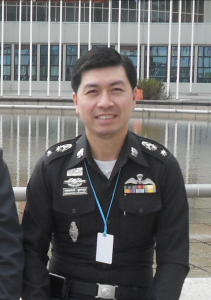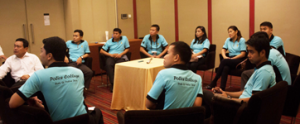LEAHN Country Focal Point
I am a Police Lieutenant Colonel with the Royal Thai Police. I am a Lecturer in the Faculty of Police Sciences, Royal Police Cadet Academy, Bangkok, Thailand. I’m also the President of the Criminology and Justice Administration Program at Rangsit University, Bangkok. I have two PhDs: the first from Thailand and the second from the University of Aberdeen, Scotland. I have recently been recruited by UNODC to work as a ‘National Consultant: Law Enforcement Liaison Adviser on HIV’. I am the LEAHN Country Focal Point for Thailand.
How did you first learn about harm reduction?
One of my police colleagues told me about the concept of harm reduction in 2012 before he asked me to attend a seminar on ‘Policing Diverse Communities’ (hosted by LEAHN) in Melbourne. At that time, the International Police Advisory Group (IPAG) was established and I became a founding member.
Have your views about drug policy changed since learning about harm reduction?
Yes, my views have changed in positive ways. More specifically, I believe that drug policy in Thai society should be seriously re-evaluated. The drug war has obviously not solved the drug problem over the longer term. Instead, it increases the chance of serious diseases becoming widespread.
What is the most common misunderstanding that Thai police have about harm reduction?
In general, Thai police have been taught that drug use is not only illegal but it is also very bad. Therefore, drug users are stigmatized as criminals and many police believe they have to be punished. Changing negative police perceptions towards drug users is a very important part of my work.
What are the barriers for police in supporting harm reduction in Thailand?
At present, I think police attitudes towards harm reduction in Thailand remain rather negative. It cannot be changed in a short period of time. However, I hope that my work helps change this culture and that police support for harm reduction can also influence government to adopt a public health approach towards some of these difficult issues for society. The police structure is also very political so this is likely to be an impediment when populist politics are at play.
In your experience, what are some of the best ways to convince more Thai police to support harm reduction?
A few strategies are required. Peer-to-peer advocacy has been a successful advocacy strategy for many kinds of public health causes. It also applies to policing. Police are more likely to listen to other police and take their advice compared to people outside the law enforcement sector. This is why LEAHN is such an important component of harm reduction advocacy. I am working on progressing harm reduction training in the police curriculum in Thailand. Broader drug policy reform is also necessary.
What are your plans for supporting harm reduction in the future?
Senior police administrators need to learn about the concept of harm reduction so that police policies will be reviewed and reformed. By delivering lectures to my police colleagues and students I hope their negative attitudes will be adjusted. I will be encouraging police trainers to attend harm reduction seminars so we can increase harm reduction training coverage although much of this depends on availability and funding.
Why is LEAHN such an important network in terms of promoting harm reduction programs?
The LEAH Network provides an opportunity for police to discuss the success and failure of drug law enforcement and harm reduction approaches in different places around the world. Police feel comfortable to share ideas and concerns with other police when they are not sure of different types of complex issues involving drug use, sex work and sex between men. The benefit of LEAHN is that we are establishing Country Focal Points who will understand the local context of policy, police and law enforcement culture to work with the police as well as a range of agencies in other sectors. In other words, we aim to identify the best fit for change to be implemented in each country.
Royal Thai Police partner with UNDP to promote key role of police in harm reduction
From Despair to Hope: A UNDP film
The film documents the successful partnership between UNDP and the Royal Thai Police, who have begun training as many as 10,000 junior cadets per year through a human-rights based curriculum designed to discourage stigma and discrimination among officers and change old attitudes about people living with HIV.
The following is an excerpt from the report:
The link between amphetamine-type stimulant use and the transmission of HIV and other blood-borne viruses in the Southeast Asia region
Thailand, officially known as the Kingdom of Thailand, has a population of 65 million. It has a constitutional monarchy. The capital, Bangkok, has a population of 7 million. Thailand is bordered to the north by Myanmar and Lao, to the east by Cambodia and Lao, and to the south by Malaysia. Thailand is a signatory to the IDADIN.
Amphetamine-type stimulant use
According to UNODC (2010b), methamphetamine has been the drug of most concern in Thailand since the mid-1990s and there is evidence that the use of crystal methamphetamine is also increasing. The UNODC report (2010b) noted that in 2009 meth/amphetamine, in pill form, was cited as the number one ranked drug of concern in Thailand and that ATS pills were the most commonly used illicit drug in the country. A 2003 National Household Survey estimated that 3.5 million Thai people had ever used ATS and half a million had used ATS in the 30 days prior to interview (Devaney, Reid & Baldwin, 2006). These numbers represent a decline in ATS use from 2001 but the timing of the 2001 survey is important with the ‘war on drugs’ commencing in 2003. A school drug use survey conducted in 2008 revealed that 12 per cent of male high school students and almost 25 per cent of male vocational students had used ATS (Thailand National AIDS Prevention and Alleviation Committee, 2010).
Manufacture, trafficking and seizures
Seizures of ATS pills almost doubled between 2007 and 2009, from 14.4 million in 2007 to 26.6 million in 2009 (United Nations Office on Drugs and Crime, 2010b). Seizures of crystal methamphetamine also increased substantially from 52.9kg in 2008 to 209kg in 2009. UNODC suggests that these increases are associated with increased trafficking from Myanmar, the result of political unrest in the area. While there is evidence of ATS manufacturing in Thailand, most of the laboratories reportedly dismantled in 2009 were small and there are no reports of the manufacture of crystal meth/amphetamine (United Nations Office on Drugs and Crime, 2010b). The majority of ATS pills in Thailand are thought to originate from Myanmar (80%) with smaller amounts coming from Lao PDR (10%). Crystal methamphetamine originates from Myanmar and Cambodia. Some of this supply is for domestic use and some is destined for other markets both in Asia and overseas.
Injecting drug use
There are an estimated 30 000 PWID in Thailand and, while smoking is the primary mode of administration of both pills and crystal methamphetamine, injection of both these substances does occur (United Nations Office on Drugs and Crime, 2010b). Geographical variations in the injection of ATS are evident: in Bangkok, 63 per cent of PWID usually injected ATS, while in Chiang Mai the figure was lower at 32 per cent (Yongvanitjit et al., 2010).
Drug-related arrests
ATS pill-related arrests decreased by 6000 between 2008 and 2009 (from 118 000 to 112 000), but remain high overall (United Nations Office on Drugs and Crime, 2010b) and account for 83 per cent of all drug-related arrests in Thailand in 2009. Arrests for crystal methamphetamine have risen annually since 2004 when there were 265 arrests. This had risen from more than 1000 in 2006 to almost 3000 in 2009. However, arrests for crystal methamphetamine account for only 2 per cent of all drug-related arrests.
Drug treatment
Of the 106 000 drug treatment admissions in Thailand in 2009, 82 per cent were for ATS pills and 0.8 per cent were for crystal methamphetamine (United Nations Office on Drugs and Crime, 2010b). There are more than 1000 voluntary treatment centres in Thailand available through general hospitals, specialised drug treatment centres, general practitioners, psychiatric institutions, religious organisations and NGOs. Thailand also has 90 compulsory centres and drug treatment programs are available in Thai prisons (World Health Organization, 2010b). During 2009 there were more than 67 000 individuals in compulsory treatment and 18 000 in voluntary treatment. Treatment for ATS is described as a combination of detoxification and behavioural, educational and 12-step counselling (Devaney, Reid & Baldwin, 2006).
HIV in the community and among high-risk groups
Population HIV prevalence in Thailand was 1.5 per cent in 2003 (UNAIDS, 2010a). Surveillance data indicate that HIV prevalence among PWID was 38.7 per cent for 2009 (UNAIDS, 2010a). Additionally, around one-third of those in drug treatment in Thailand are thought to be HIV-positive. According to a 2004 report, an estimated 5 per cent of all HIV infections in Thailand were the result of injecting drug use (United Nations Office on Drugs and Crime, 2004). However, the Thailand UNGASS Country Progress report from 2010 estimated that almost 9 per cent of HIV infections were the result of injecting drug use (Thailand National AIDS Prevention and Alleviation Committee, 2010).
The prevalence of HIV among female sex workers has declined significantly since the mid-1990s when it was estimated to be 28 per cent (Thailand National AIDS Prevention and Alleviation Committee, 2010). By 2009 prevalence was in the region of 5 per cent for both brothel-based sex workers and those working in the entertainment industry. Prevalence was higher among direct female sex workers in Bangkok at 5.3 per cent (Thailand National AIDS Prevention and Alleviation Committee, 2010). Prevalence among male sex workers is almost double at 11 per cent. Among MSM, HIV prevalence is higher, ranging from 5 per cent in smaller provinces to 31 per cent in major cities such as Bangkok, Chiang Mai and Phuket (Thailand National AIDS Prevention and Alleviation Committee, 2010).
HIV anti-retroviral treatment
While Thailand is committed to providing free ART for those infected with HIV, there is no information available for services that specifically target PWID (Hagarty, 2010).
Harm reduction
Although needle and syringe programs are not supported by the Thai Government, needles and syringes are nevertheless available in the city of Bangkok and 15 other provinces. These programs are operated by NGOs and through some pharmacies (Hagarty, 2010).
Prevention education
While direct drug prevention education has not been implemented in schools in Thailand, life skill-based education programs are being implemented. There is evidence of peer education with peer volunteers providing HIV prevention education to male and female sex workers and transgender persons in some provinces. A 100 per cent condom use program has been implemented among Thai sex workers in some areas and condom programs for MSM are reported to have been implemented (Devaney, Reid & Baldwin, 2006).




